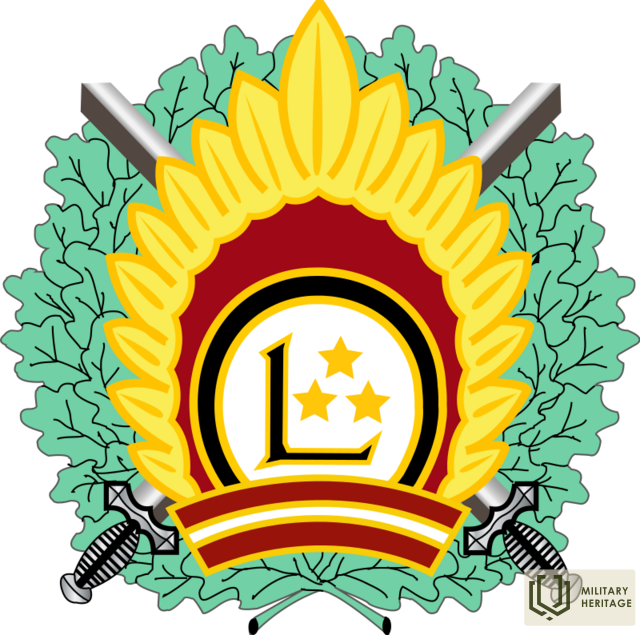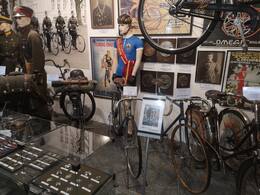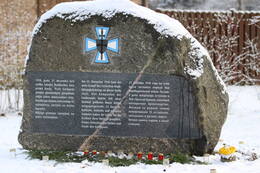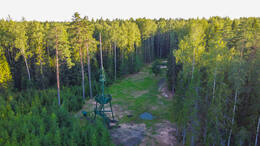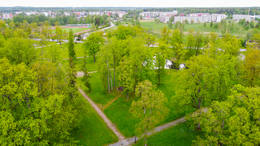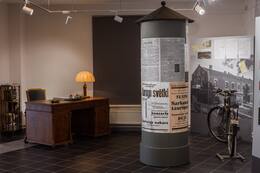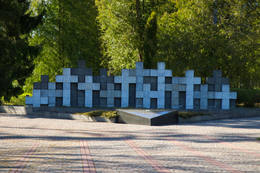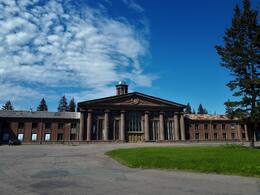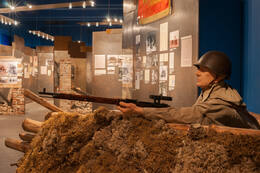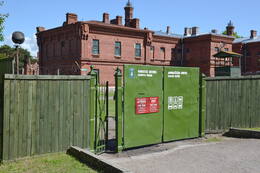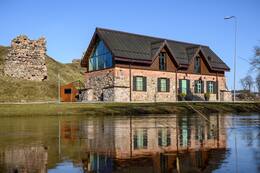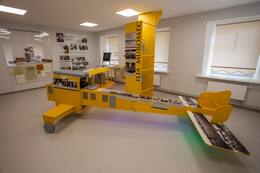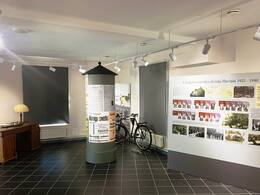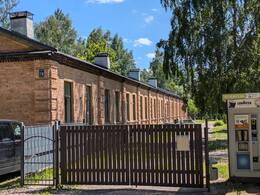Latvijas armija
I Neatkarības kari, Baltijas valstu neatkarība, II Otrais pasaules karš
1919.gada 5.janvārī tika izveidota pirmā lielākā nacionālā karaspēka vienība – Atsevišķais latviešu bataljons pulkveža-leitnanta Oskara Kalpaka vadībā. Šī vienība, kas martā tika pārformēta par brigādi, kopā ar Igaunijas teritorijā organizēto, pulkveža Jorģa Zemitāna komandēto Ziemeļlatvijas brigādi izveidoja Latvijas armiju. Jaunizveidotā armija auga un rūdījās kaujās pret bermontiešiem pie Rīgas un Kurzemē, kā arī cīņās pret lieliniekiem Latgales frontē.
Nedēļu pēc 1. pasaules kara beigām un Kompjēnas pamiera noslēgšanas 1918.gada 11.novembrī, tika proklamēta neatkarīgas Latvijas valsts izveidošana. Jaunā pagaidu valdība bija cerējusi, ka tā varēs iztikt bez regulāras armijas veidošanas, jo nevienam uzbrukt negrasījās. 1918. gada 13. novembrī Padomju Krievija anulēja Brestļitovskas miera līgumu, ar ko tā bija atteikusies no Baltijas teritorijas par labu Vācijai, un uzsāka virzību uz Rietumiem. Cerības, ka Vācijas armija pildīs savu apņemšanos aizstāvēt Latviju pret lielinieku iebrukumu, neattaisnojās.
Rīgā tikmēr formējās Latvijas Republikas Pagaidu valdībai lojālais karaspēks. 1919.gada pavasarī Latvijas bruņotie spēki sastāvēja no Landesvēra (vācbaltiešu zemessardzes), Ziemeļlatvijas brigādes un Dienvidlatvijas brigādes. Abas šīs brigādes 1919.gada 10.jūlijā apvienoja ģenerālis Dāvis Sīmansons, kļūdams par pirmo Latvijas armijas virspavēlnieku. Šī diena ir uzskatāma par dienu, kad tika izveidota Latvijas armija.
1919.gadā notika strauja Latvijas armijas apbruņošana un attīstība, tika saņemts bruņojums un ekipējums no Anglijas, Polijas un citām valstīm. 1920.gada sākumā Latvijas bruņotajos spēkos dienēja apmēram 52 000 karavīru. Neatkarības karš noslēdzās 1920.gada 11.augustā, kad tika parakstīts miera līgums ar Padomju Krieviju. Uzreiz pēc Neatkarības kara Latvijas armija sāka pāriet uz miera laika štatu. Latvijas armijā ietilpa četras kājinieku divīzijas ar trim kājinieku pulkiem un artilērijas pulku katrā. Kājinieku pulki bija numurēti un nosaukti Latvijas pilsētu vārdā. Latvijas armijai bija arī kara flote, kas sastāvēja no flagmaņkuģa “Virsaitis”, Zemūdeņu diviziona ar divām zemūdenēm “Ronis” un “Spīdola”, kā arī Mīnu diviziona ar diviem mīnu traleriem “Imanta” un “Viesturs” un vairākiem palīgkuģiem.
Armijas sastāvs formējās, pamatojoties uz vispārējo karaklausību, kam bija pakļauti visi Latvijas pilsoņi. Līdz 1931.gadam dienesta laiks bija 18 mēneši, vēlāk tas tika saīsināts līdz 12 mēnešiem kājiniekiem, 15 – pārējām ieroču šķirām. Armiju un kara floti pārvaldīja Kara ministrija. Kara ministram bija pakļauts armijas komandieris, kurš bija atbildīgs par armijas apmācību un sagatavošanu.
1940.gada 1.jūnijā Latvijas armijā bija 30 843 vīru. 1940.gada 17.jūnijā, 2.pasaules kara laikā, Padomju Savienības karaspēks savā kontrolē pārņēma visu Latviju un Igauniju. Latvijas armija tika pamazām izformēta, atvaļinot rezervē, arestējot un deportējot latviešu karavīrus. 1940.gada 27.septembrī likvidēja Latvijas Kara ministra posteni, bet 1940.gada 9.oktobrī likvidēja Latvijas Tautas armijas komandiera amatu.
1989.gada 17.jūnijā Rīgā, Latvijas Valsts Universitātes Lielajā aulā, notika Latvijas strēlnieku apvienības dibināšanas konference. Pēc kuras dažu nedēļu laikā Latvijas strēlnieku apvienībā iestājās vairāk nekā 500 bijušo karavīru. Rudenī izveidojās nodaļas un grupas Jelgavā, Tukumā, Liepājā, Bauskā, Balvos, Līvānos, Maskavā un cituviet. Sākas aktīvs darbs pie likumu, reglamentu un dažādu dokumentu izveides un izstrādes, kas būs nepieciešami armijas izveidei un pastāvēšanai.
1991.gada 10.septembrī tika pieņemts likums par valsts obligāto militāro dienestu. Sakarā ar šo likumu, visiem Latvijas pilsoņiem - vīriešiem, vecumā no 19 - 50 gadiem, jāpilda obligātais militārais dienests. Neilgi pēc šī likuma pieņemšanas, 11.novembrī, Brāļu kapos, tiek dots pirmais karavīra zvērests kopš Latvijas neatkarības atjaunošanas.
Papildus izziņas avoti
1. 100 notikumi Latvijas vēsturē. Cilvēki un procesi 1918-2018. AS “Latvijas Mediji”, 2018.
2. Dvēseļu putenis. Digitālais muzejs. Pieejams: https://www.dveseluputenis.lv/lv/laika-skala/notikums/105/sarkanas-armijas-iebrukums-latvija/ [skatīts: 08.05.2021.].
3. Nacionālo bruņoto spēku tīmekļa vietne. Pieejams: https://www.mil.lv/lv/par-mums/vesture [skatīts 08.05.202
Saistītie objekti
Militāro divriteņu kolekcija Saulkrastu Velosipēdu muzejā
Atrodas Saulkrastos netālu no Baltās kāpas, A1 šosejas un dzelzceļa stacijas “Pabaži” tuvumā.
20.gs. sākumā divriteņu pieejamību un priekšrocības sāka plaši izmantot armijās. Tika veidotas īpašas riteņbraucēju vienības, kurām piemita ļoti liels kustīgums. Riteņbraucēji vieglāk veica izlūkošanu, negaidītu uzbrukumu pretiniekam un veiklāk nekā kājnieki darboties plašā teritorijā. Pēc 1. pasaules kara arī Latvijas armijā bija riteņbraucēju vienības, kuru rīcībā bija Latvijā ražoti armijas divriteņi. Karavīram, kurš ietilpa riteņbraucēju vienībās, bija jāatbilst stingrām prasībām. Viņam bija jābūt izturīgam, ar labu redzi, dzirdi, veselu sirdi un plaušām. Svars nedrīkstēja būt mazāks nekā 80 kg, augums no 165-180 cm.
Latvijas armijā bija noteikts, ka labi sagatavots riteņbraucējam, dienas laikā jānobrauc 80-100 km, bet forsēti - līdz 150 km. Ziemas laikā, kad divriteņus nebija iespējams izmantot, lietoja slēpes. Slēpošana bija ziemas sezonas apmācības būtiska sastāvdaļa. Riteņbraucējam dienā bija jāspēj noslēpot 50-60 km attālums. Viņam bija jābūt izturīgam, daudzpusīgi apmācītam cīnītājam, pārvietojoties plašā teritorijā. Latvijas valsts veicināja karavīru gribu nodarboties ar sportu. Daudzi armijas riteņbraucēji kļuva par profesionāliem sportistiem.
Muzejā var aplūkot lielāko velosipēdu kolekciju Baltijā. Kopumā muzejā atrodas aptuveni 60 Latvijā izgatavoti un lietoti velosipēdi, tostarp, armijas parauga divriteņi.
Ekskursijas pieejamas gida pavadībā (latviešu, angļu, krievu valodā). Kontakti: +371 28883160, +371 29276832.
Piemineklis pirmajai kaujai par Latvijas neatkarību
Atroadas, Inčukalnā, Atmodas ielā 2.
2016.gada 3.jūlijā, tika atklāts piemineklis pirmajai kaujai par Latvijas neatkarību, kas veltīts Latvijas zemessardzei (Die Lettländische Landeswehr), kurā plecu pie pleca jaundibināto valsti pret boļševiku Sarkano armiju aizstāvēja vietējie baltvācieši, krievi un latvieši, kuri tolaik gan bija vienībās abās pusēs. Brāļu kapu komitejas priekšsēdētājs Eižens Upmanis tolaik secinājis, ka kauju piemiņas vietās ārpus kapiem šis varētu būt vēsturiski pirmais piemineklis apvienotajiem latviešu un baltvāciešu spēkiem. Tajā laikā par Latvijas zemessardzes jeb landesvēra latviešu vienību komandieri iecēla pulkvežleitnantu Oskaru Kalpaku, no kura vienībām Brīvības cīņu gaitā izaugusi un veidojusies vēlākā Latvijas armija.
1918.gadā visa tagadējās Latvijas teritorija bija nonākusi Vācijas impērijas un tās karaspēka rokās. Tomēr 1918.gada vasaras beigās un rudenī situācija sāka strauji noslēgties Vācijai par sliktu un bija skaidrs, ka tas ir tikai laika jautājums, kad Vācija būs spiesta atzīt sakāvi 1.Pasaules karā. Krievijas impērija, kurā Latvija ietilpa līdz 1. Pasaules karam, bija beigusi pastāvēt jau agrāk, līdz ar 1917.gada februāra un oktobra revolūcijām. 1918.gada 18.novembrī tika proklamēta Latvijas Republika. Vācijas armija, kas atradās Latvijas teritorijā, pēc pamiera noslēgšanas ar Antantes valstīm 1918.gada 11.novembrī, vairs nebija motivēta turpmākai karadarbībai un lielākā daļa tās karavīru vēlējās vienkārši atgriezties dzimtenē.
Pie šādiem apstākļiem bija skaidrs, ka Latvijas aizsardzība ir atkarīga pirmkārt no pašas Latvijas iedzīvotāju veidotas zemessardzes. Sākotnēji, pateicoties izglītotībai un salīdzinoši lielākai spējai pašorganizēties, vislielāko iniciatīvu šādas zemessardzes veidošanā izrādīja Latvijā dzīvojošie vācbaltieši. Tāpat zemessardzei pievienojās arī krievu tautības karavīri. Lai nodrošinātu zemessardzes apgādi ar uniformām, ieročiem un citiem nepieciešamajiem resursiem, Latvijas Pagaidu valdība 1918.gada 7.decembrī noslēdza līgumu ar Vācijas pārstāvi Augustu Vinnigu, paredzot zemessardzes nodrošinājumu no Latvijas teritorijā esošajām Vācijas armijas rezervēm. Šis līgums cita starpā norādīja, ka šī zemessardze ar oficiālo nosaukumu – „Latvijas zemessardze” jeb vāciski – „die Lettländische Landeswehr” būs Latvijas Republikas bruņotie spēki.
Pretīm Latvijas zemessardzei stājās divi līdz tam 1. Pasaules karā un Krievijas pilsoņu karā pieredzējušie Latviešu sarkano strēlnieku pulku karavīri (t.i. aptuveni 2000 – 3000 karavīru sastāvā). Neskatoties uz Sarkanās armijas pieredzes un skaitlisko pārsvaru, Latvijas zemessardze sīvās kaujās noturēja Inčukalnu divas dienas, līdz beidzot 1919.gada 1.janvāra vakarā, lai izvairītos no ielenkuma, bija spiesta atkāpties, zaudējot 43 kritušos, kā arī vairākus ievainotos, no kuriem lielākā daļa nonāca lielinieku gūstā, kur tika nogalināti vai nomira no bada vai slimībām.
Autors: Artis Buks. Materiāls: Laukakmens. Piemineklis izgatavots no liela izmēra monolīta akmens, kas tika atrasts Ruļļos pie Jelgavas.
Litenes armijas vasaras nometne
Atrodas Litenes pagastā, mežā, netālu no Pededzes upes.
Litenes armijas vasaras nometne ir valsts nozīmes vēsturiska notikuma vieta.
Vienīgā vēsturiskā ēka, kura saglabājusies no nometnes laikiem - pārtikas noliktava, ēku pamati. Izveidota skatu platforma, kurā plīvo Latvijas karogs, novietoti soli, labiekārtota ugunskura vieta. Ar Aizsardzības ministrijas un Nacionālo bruņoto spēku atbalstu uzstādīts demilitarizēts lielgabals. Izvietotas informācijas plāksnes.
Litenes nometnes vieta būtu apskatāma kopā ar piemiņas vietu Litenes kapos - memoriāls "Sāpju siena".
Aizsākums Litenes nometnei meklējams 1935.gadā, kad Latvijas armijas Latgales divīzijai šeit sāka veidot vasaras nometņu kompleksu. Vairāki tūkstoši karavīru Litenē no maija līdz rudenim apguva kaujas taktikas iemaņas un šaušanas māku. 1941.gada vasarā Litenē armijas vasaras nometnē tika apcietināti Latvijas armijas virsnieki. Vairāki virsnieki tika nošauti uz vietas, pārējie - izsūtīti uz Sibīriju. 1941.gada 14.jūnijā Litenes un Ostroviešu nometnē, kas atradās aptuveni 10 kilometru attālumā no Litenes, apcietināja un deportēja uz Sibīriju vismaz 430 virsniekus.
Youtube kanāla "Latvijas armija" video "Litene - Latvijas armijas Katiņa"
Litenes armijas vasara nometnes teritorijā ir informācijas stendi latviešu un angļu valodā, gida pakalpojumi pieejama latviešu un krievu valodā - T. +371 29269823 un +371 29204507.
Latvijas kara aviācijas aerodroms
Atrodas Vecgulbenes muižas teritorijā – vēsturiskajā centrā.
Gulbenē starpkaru periodā atradās Latvijas armijas garnizons, kurā bija izvietots 7.Siguldas kājnieku pulka bataljons, 1930-to gadu vidū uzsāka militāras aviācijas bāzes veidošanu, jo kara aviācijas veiksmīgai darbībai jau miera laikā jānodrošina plašs aerodromu tīkls. Īpaši nozīmīgi aerodromi tādās vietās, kur izveidojušies svarīgi dzelzceļu un ceļu mezgli.1935.gada 11.novembrī te uzsāka kara aerodroma būvniecība. Ar 1937.gadu Gulbenē izvietoja jaunizveidotu Aviācijas pulka vienību, kas kļuva par Latgales divīzijas izlūku 6.eskadriļu, palielinot armijas vienību skaitu Latvijas austrumu robežas tuvumā.
Redzama Oranžērijas ēka.
Ekspozīcija „Latvijas armija Pļaviņās 20. gs.”
Atrodas Odzienas ielā 2, Pļaviņās.
Apskatāma pastāvīgā ekspozīcija „Latvijas armija Pļaviņās 20. gs.”.
Ēkai Pļaviņās, Odzienas ielā 2, ir sena vēsture – no laika, kad Stukmaņu lieltirgotājs Hugo Apeltofts tajā uzsāka aktīvu saimniecisko darbību, tādējādi veicinādams Pļaviņu pilsētas attīstību, līdz brīdim, kad Brīvības cīņu jeb Neatkarības kara laikā šeit tika izveidots Latvijas Austrumu frontes štābs. 1919. gadā tieši no Pļaviņām tika vadīta Latvijas armijas vienību darbība pret Sarkano armiju Latgalē.
1934. gadā pie šī nama tika atklāta piemiņas plāksne ar uzrakstu: “Šai namā 1919. gadā atradās Austrumu frontes štābs, un šeit ģenerālis Jānis Balodis uzņēmās Latvijas Nacionālās armijas virspavēlniecību.” Padomju vara 1940. gadā to noņēma un iznīcināja, bet 1990. gada 16. jūnijā ar LNNK Pļaviņu nodaļas atbalstu tā tika atjaunota.
Tagad pie kādreizējā štāba ēkas atrodas piemiņas stēla, kas veltīta 15 Pļaviņu novadā dzimušajiem Lāčplēša Kara ordeņa kavalieriem, bet telpās izveidota ekspozīcija „Latvijas armija Pļaviņās 20. gs.”, kura stāsta par notikumiem Brīvības cīņu laikā, Latvijas armijas 3. Latgales divīzijas štāba darbību Pļaviņās, kā arī sniedz ieskatu Lāčplēša Kara ordeņa kavalieru dzīves stāstos.
Netālu no ekspozīcijas ēkas atrodas Latgales divīzijas štāba ēka, kuru 1913. gadā, kā Stukmaņu liķiera fabiku būvēja grāfs Teodors Medems. 1919.gadā to pārņēma P. Stučkas režīms, kur tas bija izveidojis arī cietumu. Pēc boļševiku padzīšanas, 1925.gadā ēku pārņēma Latvijas armija, kura tajā izvietoja Latgales divīzijas štābu. Šajā ēkā savu militāro karjeru izgāja 10 Latvijas armijas ģenerāļi un citi virsnieki. 1940.gadā ēku pārņēma Sarkanā armija. Pēckara gados tajā izvietojās skola, kā arī pašvaldība. Ap 1970.gadu ēku sāka izmantot ražošanas apvienība “Rīgas Apģērbs”.
Ekspozīcijas apmeklējumu iepriekš jāpiesaka zvanot T. 28442692.
Memoriāls „Sāpju siena”
Artrodas Litenes kapos.
2001.gada 14.jūnijā Litenes kapos tika atklāts arhitektu Dinas Grūbes, Benitas un Daiņa Bērziņu, akmeņkaļu Ivara Feldberga un Sandra Skribnovska radītais memoriāls „Sāpju siena”, tā simbolizē 1941.gada nogalināto karavīru atdusas vietu. 1988.gada oktobrī bijušās Latvijas armijas vasaras nometnes teritorijā Sitas silā Litenes pagastā tika atrasti 1941.gada jūnijā padomju armijas noslepkavoto 11 virsnieku pīšļi. Lai gan tos neizdevās identificēt, tomēr 1989.gada 2.decembrī, iesvētot dievkalpojumā Gulbenes evaņģēliski luteriskajā baznīcā, svinīgi pārapbedīja Litenes kapos.
11 balti krusti, piemiņas plāksne un informācijas stendi.
Spilves lidlauks
Atrodas Rīgā, Pārdaugavā, Spilves pļavās netālu no Iļģuciema.
Spilve militārā mantojuma vēsturē slavena ar vērienīgo Spilves kauju 18.gs. un Spilves lidlauku. Sākot ar 20.gs., tā tika izmantota lidaparātu izmēģināšanai, bet 1.pasaules karā kļuva par Latvijas aviācijas vēstures liecinieci.
1.pasaules karā Spilves pļavas izmantotas Krievijas armijas gaisa spēku vajadzībām cīņā pret Vācijas armiju. Līdz ar Latvijas izveidi, lidlauks kļuva par valsts gaisa spēku nozīmīgāko bāzi un lidotāju apmācību vietu. Lidlauka agrākie nosaukumi bija “Spilves gaisa osta” vai “Rīgas gaisa osta”, vēlāk “Rīgas Centrālā lidosta”. Tā bija Latvijas galvenā lidosta līdz lidostas “Rīga” atklāšanai 1975. gadā.
Iespējams, Spilves lidlauks pie Rīgas un sapnis par zvaigžņu sasniegšanu ir sekmējis daudzu latviešu lidotāju iespaidīgos sasniegumus. Varbūt tomēr Latvijas aviācijas sākums ir krietni senāks un ir meklējams Priekulē, kur kāds latviešu kalējs Zviedris ar paštaisītu ierīci veica pārlidojumu no baznīcas torņa.
Mūsdienās joprojām darbojas Spilves lidlauks. Var aplūkot 1954. gadā celto lidostas ēku, kas iemieso padomju klasicisma jeb “Staļina ampīra” stilu.
Avoti:
Irbītis, K. Latvijas aviācija un tās pioneri. Rīga: Zinātne, 2004.
Brūvelis, E. Latvijas aviācijas vēsture: 1919-1940. Rīga: Zinātne, 2003.
Valsts aģentūras “Civilā aviācijas aģentūra” oficiālā mājaslapa. Pieejams: https://www.caa.gov.lv/lv/latvijas-aviacijas-vesture-isuma [aplūkots 22.02.2021.].
Latvijas Kara muzejs
Atrodas Vecrīgā netālu no Brīvības pieminekļa un izvietots senā aizsardzības būvē.
Latvijas Kara muzejs ir viens no vecākajiem Latvijas muzejiem. Tā pirmsākumi meklējami 1. pasaules kara laikā. Muzeja krājums tika veidots galvenokārt no kaujas laukā iegūtām un karavīru personīgajām lietām. Kopš 1919. gada muzeja telpas atrodas Pulvertornī. Pēc Latvijas valsts izveides par muzeja galveno mērķi kļuva ekspozīcijas izveide par Latvijas militāro vēsturi un iedzīvotāju aktīvo lomu savas zemes aizsardzībā. 1937.gadā muzejs tika paplašināts ar piebūvi. Ēka tika celta speciāli tā vajadzībām — tehniski viens no modernākajiem tā laika muzejiem Eiropā.
Pulvertornis ir viens no bijušajiem Rīgas nocietinājumu torņiem. Tas pieminēts 1330. gadā kā Smilšu tornis. 1621.gadā, kad Rīgu aplenca Zviedrijas karaspēks, torni sagrāva. 1650. gadā tika uzbūvēts jauns tornis, šaujampulvera un ieroču glabāšanai. Pēc pilsētas nocietinājumu nojaukšanas Pulvertornis ir viena no vērtīgākajām liecībām par Rīgas aizsardzības sistēmu.
Muzejā var aplūkot 11 ekspozīcijas. Izstādīti dažādi ieroči, dokumenti, formas tērpi, apbalvojumi un citi ar karu vai karavīru ikdienu saistīti priekšmeti.
Brīvvalsts dārgumu nams
Brīvvalsts dārgumu nams atrodas blakus Rēzeknes pilsdrupām.
Unikālajā ekspozīcijā ir iekļauti vairāki simti dažādu vēstures liecību no Latvijas un ārzemju privātkolekcijām, kas aptver laika posmu no 1918. gada līdz 1940. gadam, atklājot Latgales un Rēzeknes vēstures lappuses. Tā iepazīstina ar Latvijas pirmās brīvvalsts militāro un civilo apbalvojumu vēsturi, kā arī dažādām organizācijām, kas saistītas ar valsts un pilsonisko organizāciju darbību laika periodā no Latvijas Neatkarības kara līdz Otrajam pasaules karam.
Šeit apskatāmā Latvijas brīvvalsts militāro un civilo apbalvojumu un atšķirības zīmju kolekcija ir plašākā Latvijā. Otrajā stāvā atrodas mainīgo izstāžu zāle, kur vismaz reizi gadā tiek izvietota jauna izstāde. Līdz šim apmeklētājiem bijusi iespēja apskatīt unikālu porcelāna priekšmetu kolekciju, greznus pulksteņus no Francijas un gleznas, kuru autori atspoguļojuši dažādas Latgales ainavas.
Atrodoties Dārgumu namā ir iespēja noskenēt QR kodu un noklausīties īsu audio stāstu par namā esošajiem dārgumiem. Audio stāsts ir pieejams arī IziTravel platformā ŠEIT. Stāstu var noklausīties latviešu un angļu valodās.
Preiļu Vēstures un lietišķās mākslas muzeja ekspozīcija "Jāzeps Baško - gaisa fūrmanis"
Ekspozīcija „Jāzeps Baško – gaisa fūrmanis” lidotāja, eskadriļas „Iļja Muromec” komandiera, Latvijas gaisa karaspēka organizatora, ģenerāļa Jāzepa Baško 125. dzimšanas dienai un Pirmā pasaules kara 100-gadei.
Muzeja krājuma izstāde ir kā dizaina objekts – 6 reizes samazināts lidmašīnas „Iļja Muromec” modelis, uz kura informācija atrodama tekstu un attēlu veidā. Izstādi bagātina deponējumi no Latvijas kara muzeja kolekcijām un jauniegūtā informācija no Latvijas Valsts vēstures arhīva, Spilves aviācijas muzeja un atsevišķu personu privāto arhīvu materiāliem. Jāzeps Baško pamatoti ir viens no visvairāk apbalvotajiem latviešiem un pasaules aviācijas celmlaužiem. Ar lidmašīnu ”Iļja Muromec” viņš sasniedza 4 pasaules aviācijas rekordus. Viņa vārds ierakstīts Luija Blerio Zelta grāmatā Parīzē, t.i., pasaules labāko lidotāju Zelta grāmatā.
Jāzeps Baško apbalvots ar visiem tā laika cariskās Krievijas ordeņiem, Latvijā – Triju Zvaigžņu ordeņa 3. šķiru, Viestura ordeņa 2. šķiru, Aizsargu nopelnu krustu, kā arī ar Čehoslovākijas, Igaunijas, Somijas un Polijas augstākajiem apbalvojumiem.
Dienējis cariskās Krievijas armijā, boļševiku Sarkanajā armijā, bet 1921. gadā pārnācis dienestā Latvijas armijā. Pēc Latvijas okupācijas no dienesta atvaļināts.
Ekspozīcija „Latvijas armija Pļaviņās 20. gadsimtā”
Latvijas armijas izveidei veltītā ekspozīcija atrodas Pļaviņās. Ēkai, kurā izvietota ekspozīcija, ir sena vēsture. Līdz ar Stukmaņu (tagad Pļaviņu) dzelzceļa stacijas izveidi, apkārtnē sāka būvēt mājas, un viena no tām, celta 1900. gadā, bija tirgotāja Hugo Apeltofta nams. Ēka būvēta kā tirgotāju nams, taču vēlāk tā kļuva par vietu, kur dzima Latvijas armija.
1919. gada jūlijā, Neatkarības kara laikā, ēkā tika izvietots Latvijas Austrumu frontes štābs. 1934. gada 17. jūnijā, par godu šim notikumam, pie ēkas tika atklāta piemiņas plāksne ar uzrakstu: “Šai namā 1919. gadā atradās Austrumu frontes pavēlnieka štābs un šeit ģenerālis Jānis Balodis uz ņēmās Latvijas nacionālās armijas virspavēlniecību.” Plāksne tika atjaunota 1990. gada 16. jūnijā. 2019. gada 10. jūnijā pie kādreizējās štāba ēkas tika uzstādīta piemiņas stēla, kas veltīta Pļaviņu novadā dzimušajiem Lāčplēša Kara ordeņa kavalieriem.
Ekspozīcijā izvietoti informatīvi stendi ar vēsturiskām fotogrāfijām, kartēm, un informāciju par Latvijas Austrumu frontes štāba izveidošanu.
Latgales artilērijas pulka armijas kazarmas
Latgales artilērijas pulka armijas kazarmas uzbūvētas kā trīsstāvu moderna ēka pēc arhitekta Vernera Vitanda projekta 1931. gadā. Šī monolīta dzelzsbetona celtne bija viena no pirmajam Latvijā. Tās ir saglabājušās, atrodas Krustpils muižas teritorijā, blakus pils parkam. Mūsdienās saglabājusies trīstāvu ēka ir Jēkabpils pašvaldības neapsaimniekots īpašums. Logu ailas bez logiem, ēkā iekļūšana nav iespējama, ēka apskatāma no ārpuses. Pašvaldība veikusi jumta nomaiņas darbus. Nākotnē paredzēts ēku atjaunot tur izvietojot dažādas organizācijas, un to nodot lietošanā uzņēmējiem.
Latgales artilērijas pulks sastāvēja no diviem divizioniem, katrā divizionā bija divas lielgabalu un viena haubiču baterijas, kopā pulkā bija 16 lielgabalu un astoņas haubices. Pārējās pulkam pierakstītās artilērijas vienības glabājās iekonservētas noliktavās un bija paredzētas kara gadījumā trešā diviziona formēšanai.
Rīgas garnizona armijas telšu nometne
Tagad šeit ir krūmi un brikšņi, bet pagājušā gadsimta trīsdesmitajos gados, šeit atradās Rīgas garnizona armijas vasaras nometne. Dažviet vēl var redzēt tādus kā taisnstūra formas vaļņus. Šajās vietās atradās karavīru teltis, kas bija izkārtotas četrās garās rindās, bet pa vidu – mazas ieliņas. Rindu galos slējās garnizona vienību logo – tie bija izlieti no betona, bet ornamenti un uzraksti veidoti no maziem, krāsainiem akmentiņiem. Vaļņi ap teltīm bija nepieciešami ne tikai mitruma aizturēšanai, bet arī militāriem mērķiem. Ja nu Mangaļsalā ienāktu desanta karaspēks, tie tiktu izmantoti kā ierakumi, kuru aizsegā aizsargāt teritoriju no ienaidnieka. Lai gan šeit norisinājās reālas militāras apmācības, gaisā valdīja romantiska idille, kas redzama arī tā laika fotogrāfijās. Jaunieši spēlēja volejbolu. Virsnieku namiņu pagalmos bija iekoptas lapenes un puķu dobes. Pie kareivjiem brīvdienās ciemos brauca mīļotās, kas līdzi veda zemeņu grozus un svaigu maizi. Maltītes visi lielākoties ieturēja laukā pie galdiņiem svaigā gaisā.
Armijas pilsētiņa
Šajā apkaimē pagājušā gadsimta divdesmito gadu beigās un trīsdesmito gadu sākumā Latvijas armija uzcēla armijas pilsētiņu virsniekiem un karavīriem, kuri strādāja Mangaļsalā. Vēlāk pilsētiņa līdz ar Mangaļsalas militāro bāzi nokļuva padomju savienības īpašumā. Te dzīvoja civilpersonas bez noteikta statusa, bet vēlāk tika izveidoti sociālie dzīvokļi maznodrošinātām personām. Labajā pusē bija gan futbola laukums, gan mazdārziņi, bet ar laiku tie pārvērtās pļavās un purvos. Vēlāk jau šeit parādījās privātmājas un autoserviss. Līdz 1960. gadiem Mangaļsala nemaz nebija Rīgas, bet Mangaļu pagasta daļa. Toreiz cilvēki šeit nodarbojās ar zvejniecību vai strādāja armijas bāzē, jo lauksaimniecība bija praktiski neiespējama – aramzemes platība Mangaļsalā ir tikai 3,8%. Kādreiz cauri pilsētiņai tieši gar Mangaļsalas ielu kursēja šaursliežu dzelzceļš, bet pati iela bija bruģēta. Tagad bruģis ir paslēpts zem asfalta kārtas. Ceļa galā ir ostas teritorija un bijusī militārā piestātne. Kādreiz tur bija pietauvoti armijas kuģi, un starp tiem izbūvētas laipas.
Apskatāma no ārpuses, ejot pa Mangaļsalas ielu.
Saistītie stāsti
Par pirmo Latvijas armijas virspavēlnieku Dāvidu Sīmansonu
Grāmatas “Latvijas armijas komandieri” esejas pārliecina, ka vēsturi būtiski ietekmē konkrētas personas. Lai arī neilgu laiku esot svarīgāko vēsturisko notikumu epicentrā, īsteni Latvijas patrioti ar savu bagātīgo militāro pieredzi, paspēja paveikt daudz Latvijas armijas veidošanā, stiprināšanā un vēsturisko notikumu gaitu pavērsienos.
Šis stāsts ir par pirmo Latvijas armijas virspavēlnieku Dāvidu Sīmansonu (1859-1933).
Latvijas armijas ģenerāļa, divkārtējā Lāčplēša Kara ordeņa kavaliera Pētera Radziņa piemiņai
Ģenerālis Pēteris Radziņš, dzimis Valkas apriņķa Lugažu pagastā vienkāršā lauksaimnieka ģimenē, kurā iemācījies darīt lauku darbus. Bijis ļoti gudrs jaunietis, pēc skolas beigšanas izlemj par labu kara gaitām un tā sākās viņa armijas gaitas izglābjot Latviju no Bermonta karaspēka. P.Radziņš bija viens no izcilākajaiem Latvijas armijas virsniekiem un apbalvots ar neskaitāmiem Latvijas un ārvalstu ordeņiem un piemiņas zīmēm.
Armijas klātbūtne Mangaļsalā
Atmiņās spilgti iespaidi par Latvijas armijas klātbūtni Mangaļsalā. Aprakstīti forti kā arī Sapieru celtais dzelzsbetona nocietinājums. Atmiņas raksturo karavīru ikdienu, dzīves ritmu un ilustrē vidi Mangaļsalā. Mangaļsalas un Latvijas armijas karavīru apmeklējums
Atmiņas par Kara muzeja izveides sākumu
Teicējs apraksta apstākļus kādos izveidojās Kara muzejs. Pieminētas problēmas un kolekciju veidošanas darbs.
Vienotās Aviācijas svētki- īsti tautas svētki
Teicējs apraksta vienu no Latvijas populārākajiem un plašāk apmeklētākajiem pasākumiem – Aviācijas svētkus Spilvē. Raksturo svētku noriesi un vērienu. Tiek uzsvērta aviācijas popularitāte Latvijā.
Par Sudrabkalniņa atklāšanas svētkiem
Atmiņu stāsta izvilkums no ģenerāļa Jāņa Baloža uzrunas Sudrabkalniņa pieminekļa atklāšanas dienā. Pilnā tekstā ir atstāsts par atklāšanas pasākuma norisi, Valsts prezidenta Kārļa Ulmaņa un ģenerāļa Jāņa Baloža uzrunas. Atmiņas izvēlētas, jo spilgti parāda to kādā stāvoklī bija Latvijas armija, kura cīnās Sudrabkalniņa apkaimē.
Par Daugavgrīvas cietoksni
Teicējs apraksta notikumu Daugavgrīvas cietoksnī, 1. pasaules kara laikā, kad to bombardēja Vācijas armijas dirižablis. Cietoksnis bija viens no stratēģiskajiem objektiem, kas saglabāja savu nozīmi līdz pat 2. pasaules kara beigām.




